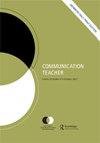Introducing a complex communication paradigm through a system self-analysis
IF 0.4
Q4 COMMUNICATION
引用次数: 0
Abstract
This activity helps students conceptualize and apply systems theory principles to a family communication context by having them create personal whole systems using paper, string, index cards, and the floor. In completing this exercise, students see how their subsystems interact and emerge as something greater than the sum of their parts. They also grasp how environmental factors and feedback loops influence change and impact growth. Finally, this exercise helps students identify the complexities and interconnections of individual and family units. Courses Family Communication. Objectives At the end of this exercise, students will be able to: (1) describe whole systems, subsystems, environmental factors, and feedback loops; (2) show how multiple subsystems interact and emerge as something greater than the sum of their parts; and (3) see how inputs transform into outputs that contribute to a system’s evolution.通过系统自我分析引入复杂的通信范式
这个活动通过让学生使用纸、绳子、索引卡和地板创建个人的整体系统,帮助学生概念化和应用系统理论原理到家庭交流环境中。在完成这个练习的过程中,学生们会看到他们的子系统是如何相互作用的,并以比各部分总和更大的形式出现。他们还掌握了环境因素和反馈循环如何影响变化和增长。最后,这个练习帮助学生识别个人和家庭单位的复杂性和相互联系。课程家庭沟通。在本练习结束时,学生将能够:(1)描述整个系统、子系统、环境因素和反馈回路;(2)展示多个子系统如何相互作用,并以大于其各部分之和的形式出现;(3)了解如何将输入转化为有助于系统演化的输出。
本文章由计算机程序翻译,如有差异,请以英文原文为准。
求助全文
约1分钟内获得全文
求助全文

 求助内容:
求助内容: 应助结果提醒方式:
应助结果提醒方式:


